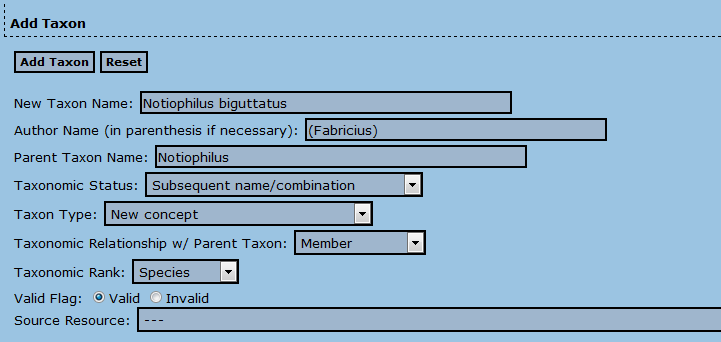DB Manager :: Add new species
Introduction
This page will direct an xBio:D user on the procedures to follow in order to add a new valid species or another valid taxon at a different rank into the xBio:D database. Only users with taxonomic permissions and possess the taxonomic authority upon a certain group are able to manage taxonomies, so if you would like to contribute to the xBio:D taxonomic resources, please contact hol-help@osu.edu and request permission.
NOTE: Please understand the xBio:D Taxonomic Data Model before using any of the taxonomic features of the Database Manager.
Check for Existing Species
Before adding a new valid species or taxon at any rank, it is crucial that the species concept is not already within the xBio:D database. All taxa are available through HOL, which will also list obsolete combinations for species, common names, as well as subjective synonomies of other species, and can easily be discovered via search. A species concept can have only one valid name associated with it and is considered the current combination. All other names that are also part of the concept are considered to be obsolete combinations. Any new species concepts added to the xBio:D database should also include the original combination (also known as a protonym or basionym), the species names used when first described and made available (see Wikipedia for basic definition of what an available name is). A common/vernacular name, although unavailable and unable to be considered valid according to nomenclatural codes, is also treated as an obsolete combination but is clearly marked as a common name in much the same way a misspelling of a species name is unavailable and never valid. If an obsolete combination is found for a species concept, go to DB Manager :: Transfer species for existing concept for directions on how to proceed. Only after a species concept has been confirmed to not already exist should a new species be added.
Add Species in DB Manager
Go to the Add Taxon page of the DB Manager to begin. Since you are adding a new, valid species into the xBio:D database, make sure that the "Taxon Type" field is set to "New concept", the "Taxonomic Relationship..." field is set to "Member", the "Valid Flag" field is set to "Valid", and the "Taxonomic Rank" field is set "Species" or whichever rank is proper.
In the "Parent Taxon Name" field, enter any of the names that are associated with the parent taxonomic concept for the new species you are adding, which for a species should be a genus-group name. Setting the parent concept to a subjective synonym of another valid genus may be preferential in some cases. These may be when a type species is desired to be linked to an invalid genus or when subgeneric relationships with species are desired to be maintained where the subgenera are marked as invalid.
The "Taxonomic Status" field should reflect the proper nomenclatural status of the name for the new species. In this part, only the zoological (ICZN) conventions for naming will be used, but other nomenclatural codes can also be applied here. If the species name is valid as it was originally described, then the status should be "Original name/combination" and the "Author Name..." field would merely have the author's last name. If the valid species name was subsequently moved into another genus, then the status would be "Subsequent name/combination" and the author would be the author's last name within parenthesis. However, if the valid species names included a misspelling of the original genus name or a mark of ambiguity, like a question mark (?), was used for the genus name but since has maintained within the genus, then the status would be "Subsequent name/combination", but the author would not include parenthesis since it is in the same concept with a different spelling. In cases when a new name (nomen novum) is being entered as valid in the combination that was used to replace a junior homonym, then the status should be "Replacement name" with the author's name without parenthesis. If a replacement name is subsequently moved into a different genus, then the name should be treated as any other valid, subsequent combination. The only other acceptable, albeit rare, nomenclatural status for a valid species is "Justified emendation", which is only used when an original specific epithet is invalid formed (see the ICZN code for details).
After a valid species is entered, continue to the DB Manager :: Add obsolete species name page to add an obsolete combination for an original spelling, junior homonym, common name, or any other invalid subsequent combination that should be discoverable for the newly entered species concept.


